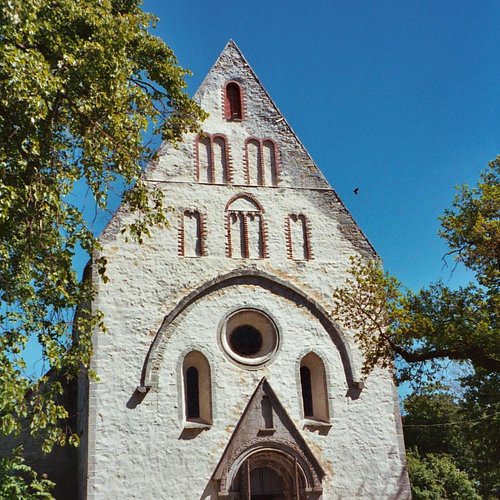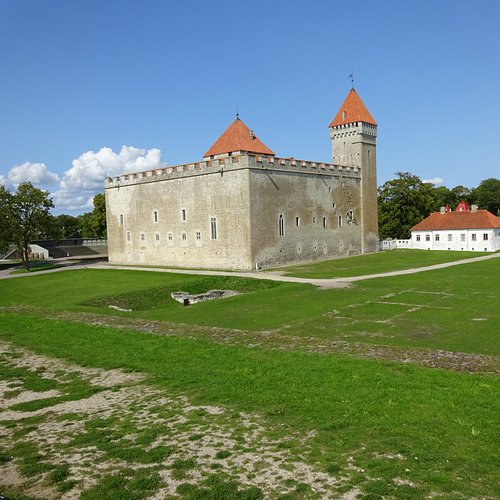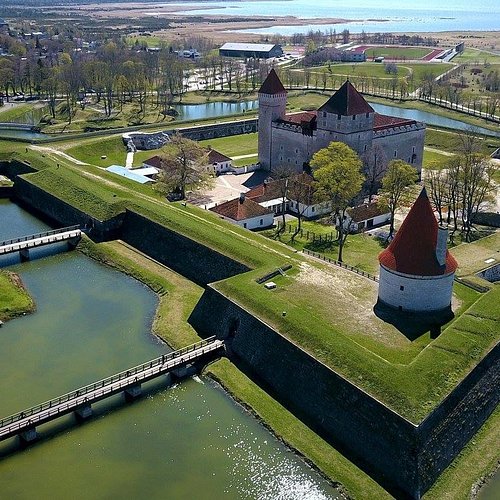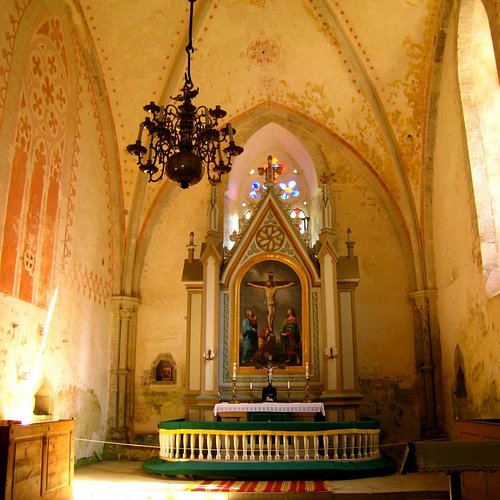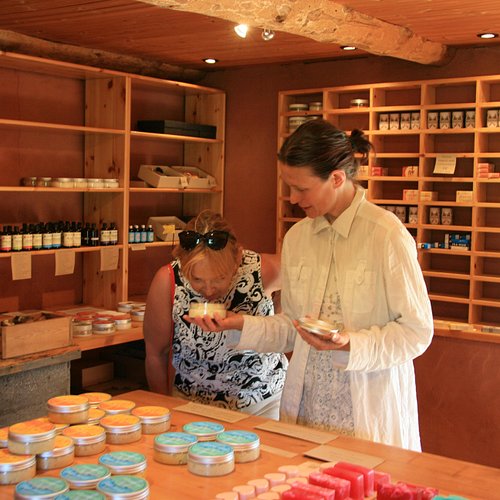Top 10 Sights & Landmarks in Saare County, Saare County
Discover the best top things to do in Saare County, Estonia including St. Madeline's Church, Saint Martin's Church, Reomae Apostel Andrease kirik, Medieval Activity Centre Archebald, Saaremaa Museum, Kuressaare Castle, Karja Catherine Church, St Catherine’s Church, St. Mary's Church, Good Kaarma.
Restaurants in Saare County
1. St. Madeline's Church
Overall Ratings
5.0 based on 6 reviews
St. Madeline's Church in Ruhnu is the oldest known wooden building still standing in Estonia - its construction was started in 1643. After the Ruhnu Swedish left, the purpose of this house of God was forgotten for half a century. The wooden church was newly consecrated in 1999.Good to know:The collection of glass paintings from the Ruhnu wooden church is located in the History Museum in Stockholm.The oldest parts of the building are the polygonal choir and altar, and the nave.The altar is covered with a thin, polished stone slate; the oaken frame stands on sand and is open towards the south.
2. Saint Martin's Church
Overall Ratings
5.0 based on 5 reviews
The construction of Valjala Church was started in 1227. The oldest part of the church is the choir room to which the nave was later added. At Valjala Church you can see a Romanesque baptismal font from the 13th century, which is believed to be one of the most unique pieces of carved stonework in the Baltic states. In the choir room of the church you can marvel the murals which depict six apostles and are painted at the time when the original chapel was built - the later choir room part. Good to know: * Valjala Church is the oldest stone church built on the territory of Estonia. * In the third quarter of the 13th century, the church was transformed into a fortified church * The church tower was built in the 17th century above the vestry.
Reviewed By PBTravelstheWorld - Woodinville, United States
This is the oldest church in Estonia and you can see that in the architecture. The Romanesques blind arcading across the top of the front and the very thick walls all show building of an earlier time. It is a simple church that needs some care. The walls have some alge growing on the inside, but it was open and neat the day I visited. Because this church was out on the islands it survived and the people of the islands were able to keep their faith better then on the mainland. The church is free to visit, but a small donation would help them to keep it open and safe for future visitors.
3. Reomae Apostel Andrease kirik
4. Medieval Activity Centre Archebald
Overall Ratings
5.0 based on 8 reviews
5. Saaremaa Museum
Overall Ratings
4.5 based on 217 reviews
The Kuressaare episcopal castle, also known as the Kuressaare Castle, was built in the 14th century. Today, the castle houses the Saaremaa Museum which is devoted to the island’s nature and history. A large part of the fun is exploring the warren of chambers, halls, passages and stairways, apt to fuel anyone’s fantasies. One room near the bishop’s chamber looks down to a dungeon where, according to legend, condemned prisoners were dispatched to be devoured by hungry lions (recorded growls reinforce the mental image). Legend also tells of a knight’s body found when a sealed room was opened in the 18th century, which has given rise to varying accounts of how he met his tragic fate. Upon discovery the knight’s body dissolved into dust but don’t worry, it’s since been re-created. There’s also interesting coverage of daily life under the USSR, including the interior of a typical apartment. On the top floor, the museum has wonderful views over the bay and surrounding countryside.
Reviewed By lindaaa2020 - Tallinn, Estonia
it's honestly one of the most interesting castle museums I've ever been to here in Baltics - you can spend easily hours there as there's many different exhibitions. On the top floor there's also cafe opened - good coffee!
6. Kuressaare Castle
Overall Ratings
4.5 based on 260 reviews
Kuressaare Castle-Fortress is built in the 14th century. Today, the castle houses the Saaremaa Museum. Saaremaa Museum is one of the oldest (founded in 1865) and biggest museums in Estonia and is visited by 70 000-80 000 people every year. As a county museum its main function is to preserve and strengthen the identity of Saaremaa as a region with extraordinary nature, history and culture. The museum tries to exhibit the essence of the castle and tells its story to the whole world.
Reviewed By Imre-GustavV - Tallinn, Estonia
My 1st visit there (or may-be not in a case I was there ca 40 years ago and just do not remember). Renovators have made a good work and the whole area is really nice. Also they have several permanent very interesting exhibitions about several historical periods there. Also a roof-terrace is open for a walk. Every summer famous "Saaremaa Opera Days" are organized by Estonian National Opera there (unfortunately I have not visited yet) and I can say that it is a perfect place for that opera festival! P.S. Beach is ca 50m from there so take your swimming suit and towel with.
7. Karja Catherine Church
Overall Ratings
4.5 based on 16 reviews
Karja church was built in the beginning of 14th century. The church has retained almost unchanged its initial shape. The church is one-naved and doesn't have bell tower. On top of the altar are extant paganish magic ceiling signs that were painted during construction.In the design of the church You will mostly see elements of early and high Gothic that are combined with some roman lines.Interesting to know: Karja church is one of the richest of sculptures in the whole Northern Europe.The arcs of the church exceed the height of the walls two times.Karja church is the smallest church on Saaremaa.
8. St Catherine’s Church
Overall Ratings
4.5 based on 26 reviews
Muhu Church has been mentioned in chronicles since 1267. The church is a beautiful building in early Gothic style. The interior of Muhu Church boasts high ceilings with high domical arches and cross vaults in the choir section. Fragments of murals that date back to the 1330s have been preserved on the northern and eastern walls of the church’s choir room.You can see a rare trapeze-shaped grave plate from the 13th or the 13th century in the church wall above the door leading to the staircase.Interesting facts:Muhu Church is one of the rural churches with the most beautiful proportions in Estonia.The pulpit of Muhu Church is one of the oldest in Saare County.The church has also been used as a defence facility.
9. St. Mary's Church
Overall Ratings
4.5 based on 6 reviews
The Poide Church was built in the middle of the 14th century on the ruins of the Poide Order Castle. The existence of the castle is witnessed by the ruins lying under ground north of the church. Lower parts of the side walls of the church now standing there are the only ones remaining from that period.Near the southern wall of the church, you will see trapezoid-shaped gravestones and their fragments walled into the floor of the choir.Good to know:The Poide Church is the biggest single nave church in Western Estonia and the islands.The rich carved decor of the church is one of the best examples of Estonian High Gothic.The main portal of the church is situated to the south, not to the west like in other churches.
10. Good Kaarma
Overall Ratings
4.5 based on 18 reviews
GoodKaarma is a unique ecofarm which makes organic soaps. In summer our doors are open to everyone. Our outdoor cafe offers drinks and snacks, while our gift shop has a wide range of interesting souvenirs, jewellery, soaps and more. Those interested can even take part in soap-making workshops!
Reviewed By nycladybug - New York City, United States
I visited Good Kaarma as part of a G Adventures tour I was traveling with. The owners have done a great job creating an inviting, warm environment that radiates with loving energy. The morning that we went to Good Kaarma to learn more about soap making, my stomach wasn't feeling well. Our tour guide told the owner and she immediately made me a hot drink with apple cider vinegar and within 30 minutes I felt like a new person. The soaps smell so good and are made with all natural ingredients. I would highly encourage making this a stop if you visit Saaremaa Island.


